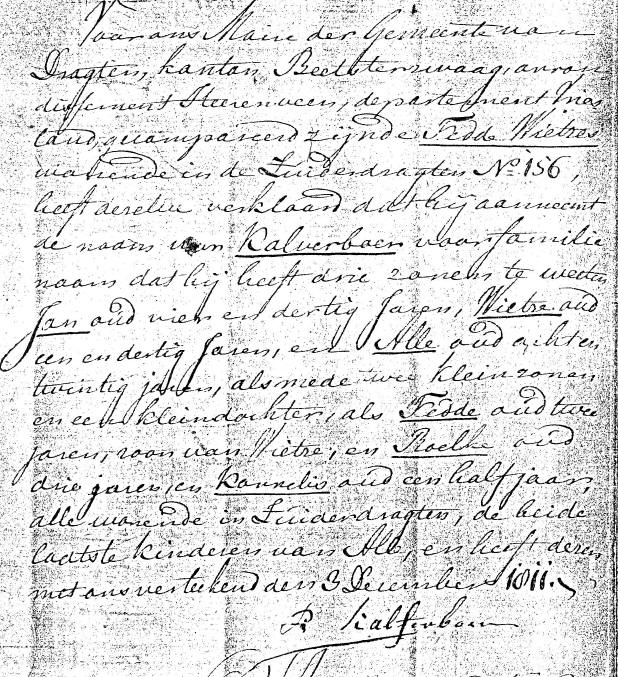10697 Family names adoptions, from 1812 till 1835
Edited and compiled by Dave Verdooner and Harmen Snel
Register of Name Adoptions
The adoption of names by Jews always showed great regional differences. When the Sephardim, the Jews from the Iberian peninsula, settled in the Netherlands at the end of the 16th century, they continued to use in most cases the surnames they had in their country of origin. The Ashkenazim, the Jews that came in great numbers from Germany and Poland, especially after 1634, used only their private name, mostly in conjunction with the first name of the father (the so-called patronymic).
Sometimes another name was added to this combination of names, mostly derived from the place of origin.
Both private names as well as surnames underwent adjustment to the Dutch language, like Hirsch and Mordechai, that became Hartog and Marcus resp. and Preger that turned into van Praag.In the course of the 18th century, with the increase in the Ashkenazi segment among the Jewish population in the Netherlands, we notice an increase in the use of surnames, but generally this remains limited to the better situated among the Ashkenazim.
This was so, because they had more to do with the authorities, and also in their commercial relations the use of a recognizable surname was of importance.
The majority of the Ashkenazim in the western and southern parts of the Netherlands did not use surnames, in contrast to other parts of population in these regions, until Napoleon decided that this finally should be changed.
The Emperor Napoleon decided on 20 July 1808 and on 18 August 1811 by “decreet” (Bulletin des Lois de l’Empire Francais,nr. 3589 and 7178) that all inhabitants of the empire had to register themselves with a private- and surname.
The French authorities began executing these decrees and started immediately with the registration. In the western and southern parts of the Netherlands this concerned mostly Ashkenazi Jews who did not use a surname as yet.
In the northern and eastern parts of the Netherlands only a small part of the total population used a fixed surname, so the Ashkenazi Jews who had to have themselves registered, were a minority. Not everyone heeded the call to have themselves registered with a new surname or with the one already in use.
One of the reasons was the fear of conscription (in the army).Another reason was that Jews, who started residing at a certain location only a short time ago, and were not sure that they would be permitted to stay, tried to avoid the registration.
Males who made their living on the road (circus artists, traveling merchants) will be found sparsely in the name adoption registers.
Many may have thought also, that it sufficed if their brother, uncle or other relative registered. They then simply use the name chosen by their relative.
The decrees on the name adoption were in fact mostly directed towards the male head of the families. In cases, where the male head of the family passed away prior to 1811, it was the intention, that the widow would adopt a name for herself, her children and grandchildren. She herself could use a name that was adopted by her relatives. The same rule was in force for unmarried women or women without children, who were not obliged to have themselves registered, but who were supposed to use a surname. As not everybody had made the effort to get a new (or old) name, King Willem I of the Netherlands offered another opportunity to do so in November 1825 (Koninklijk Besluit of 8 November 1825 - Staatsblad 1825,nr.74), this time accompanied with severe penalties in case of disobedience. Much use was not made of this renewed opportunity to register.
In Amsterdam the Name Adoption Registers comprise 7 volumes (volumes A till F, and a supplement 1813-1826), kept at the Amsterdam Municipal Archives.
For the Civil Registration, first of all, the private name, the patronymic, (and if appropriate, the surname already in use) were registered.
The person in question could declare whether he wanted to keep his private name and patronymic or whether he preferred to change them into more Dutch sounding (private) names. Those who already used a surname long before 1811 (like Blitz, Polak, van Praag) kept those names or adopted nevertheless another name.
Those who did not use surnames in their contacts with the authorities before 1811, were now obliged to adopt a new surname. More often than not they did use a surname within Jewish circles, that identified them from others, but those names were not used outside their own circle for registration purposes, like the preliminary marriage announcement (“ondertrouw”).
Besides the old and new adopted names of the individual involved, his address was entered and also the number of children and grandchildren the name was adopted for or maintained.
Those children and grandchildren were all registered with private names, age and where they lived. In cases, where the son was married, the name of the spouse was also given (in most cases).
The names adopted or maintained in Amsterdam show the following main divisions, based on location of origin (like van Embden, van Heeks, Speijer), on occupations (for instance Kornalijnslijper, Melkman, Viasschraper), on functions in the Jewish community (like Koster, Psalmzegger, Voorzanger), on patronymics (like Arons, Davids, Zadoks), on French names (like le Loup, Marchant, de la Meuse), on names of animals (for instance Kater, Koe, Konijn).
At the same time there were those, who did not take the new measure too seriously and jokingly took ludicrous names like Hazelip or Leegloper.In Amsterdam 2880 certificates of name adoptions were drawn up for a total of 10995 persons, of which 2134 cases concerned the adoption of a new name.
